Indra has disclosed preliminary results from its extensive vehicle-to-home (V2H) EV charger trial, which is currently the largest of its kind globally.
Indra has previously explored the benefits of V2X, noting that it had the ability to “power the future,” but now it finally has early results from its self-funded trial.
The trial involves over 200 bidirectional chargers fitted in homes across the UK, with the aim to determine the feasibility of V2H technology as a marketable product. Key outcomes shared reveal that trial participants have collectively reduced their peak household electricity use by over 100 MWh. This significant saving translates to powering an electric vehicle for roughly 430,000 miles.
Participants achieved these savings by using their EV’s battery to supply power during peak energy times and recharging during off-peak periods when electricity is less expensive and more environmentally friendly. Additionally, those with solar panels were able to further benefit by using the energy they generated.
The trial also highlighted potential financial benefits, with 50% of participants expecting to save between £400 and £799 over twelve months. Another 18% foresee savings of £800 to £1,199, with 10% predicting even greater savings. Some have effectively received negative energy bills during sunnier months due to earning from energy sold back to the grid.
John Fox, Indra’s Chief Technology Officer, revealed the findings during the Cenex Expo 2024, where he stated, “Everyone here at Indra is delighted to be leading this pioneering trial which is providing incredibly valuable data and insights, which we will use to deliver a valuable and enjoyable experience to users as we bring this technology to the masses.
“As expected, we’ve already shifted a significant amount of energy, supporting the grid and reducing carbon and this is only going to keep increasing as the trial continues. We’ve had some fantastic feedback from trialists on the savings they have made on their energy bills, and I can say from personal experience the savings are very much real – I’m around the £800 saving per year mark, with no solar panels at my home. This real-world evidence is vital in supporting our mission to bring the benefits of bidirectional EV charging to as large a number of people as possible.”
In a bid to make this technology more accessible, Indra has included customers from the Motability Scheme in the trial, gathering unique insights from disabled users. This inclusivity aims to ensure that the benefits of bidirectional charging are available to a diverse range of consumers.
Furthermore, Indra is collaborating with EDF Energy and the Department for Energy Security and Net Zero on a project to integrate its bidirectional chargers with a novel EDF electricity tariff designed to optimise the use of bidirectional EV charging. This project began in March 2024 and is part of ongoing efforts to mainstream V2H charging technology.

